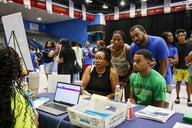You have /5 articles left.
Sign up for a free account or log in.
Over the last few years, a startling number of college and university presidents have suddenly lost their jobs. The trustees and faculty members at Pennsylvania State University, Michigan State University and, most recently, the University of Southern California have all seen their presidents resign. Other campuses have also experienced similar eruptions.
A handful of well-publicized downfalls by college and university presidents doesn’t necessarily suggest all of academe is in similar danger. After all, with more than 4,600 degree-granting postsecondary institutions in the United States, trends rarely apply to every sector. Still, the resignations suggest something different from the norm is at work in academe.
So what went wrong at those institutions? Conjectures abound, but many of them don’t hold up to scrutiny. Here are four often-blamed factors that don’t cause the downfall of university presidencies:
The structure of the board. After every resignation, recommendations for reform have focused on reshaping the Board of Trustees. At Michigan State, for example, the board was said to be too small and insular; at USC, too large and opaque. At Penn State, the board was accused of being asleep at the wheel. Looked at as a whole, no discernible pattern emerges -- a clear sign that a structural flaw in the academic system did not cause the problems.
Conflicts among the faculty, board and administration. At some colleges and universities, the governing groups have contentious relationships. New board members might want to oust a president to pursue a different path for the institution. Faculty members might distrust the president and come across as being out for blood. Such was not the case, however, in any of the recent governance controversies. Indeed, a claim could be made that the opposite was true: faculty members were largely compliant, raising no warning flags about their leaders. And the boards either had no idea of the problems that existed or simply thought the president was doing a great job.
Problematic presidential personalities. Penn State’s president was often lauded as a model to emulate. Lou Anna Simon received plaudits for her leadership at Michigan State. USC’s Board of Trustees gave its president a $1.5 million bonus a year before firing him. How is it possible that a leader can be popular and supported by their boards and the faculty one day yet then relieved of duty the next?
Presidential abuse. In all recent cases, the presidents were peripheral to the controversies rocking their institutions. At Michigan State, a trainer committed a series of crimes. At Penn State, a former football coach was the guilty party. At USC, a medical school dean, and then a gynecologist, were the individuals at the center of the storm.
What, then, are we to make of this string of presidential resignations? Distinct issues in each of these institutions’ cultures played important roles, but a key common problem has to do with a lack of shared governance.
Colleges and universities are interpretive communities where individuals make sense of actions and policies through a shared discourse that gets enacted by way of governance. Shared governance, however, on each of these campuses, was weak. Boards of trustees and faculty members ceded far too much power to administrators to make decisions.
Many institutions see a clear benefit to consolidating power: speed. A continual drumbeat in academe has been that higher education is plagued by slow decision making -- a lethargy that could doom academic institutions in an age defined by the speed of social media. Faculty members are said to prevent institutions from acting nimbly; if college presidents had more leeway, colleges could achieve more, more quickly, goes the argument.
Such arguments have been winning out. The result is that boards and faculties have largely ceded their roles in shared governance to the president and the administrative minions -- with disastrous consequences. The lack of shared responsibility can be seen in each of the institutions that lost their presidents.
The way forward has to be an acknowledgment that “shared” governance suggests that faculty members are active decision makers. Faculty members will see issues differently from administrators or the board -- and that is not a bad thing. Different perspectives enable creative conflict to occur, and out of that comes more informed decision making and more involvement from all constituencies.
Shared decision making takes time, but it need not be interminable. Some decisions require a rapid response, but what is really needed for the vast majority of issues is agreement on an agenda and time frame. Faculty members tend to focus on processes; administrators like to make decisions. What we need going forward is active faculty and board engagement with issues and policies in deliberative forums that make decisions rather than just debate them.
Colleges and universities certainly need to acknowledge a more competitive academic environment framed by digital technologies that require faster response times than in the past. But to ignore the failures of governance is to welcome further problems in other institutions, and ultimately, threaten the excellence that has defined higher education.




